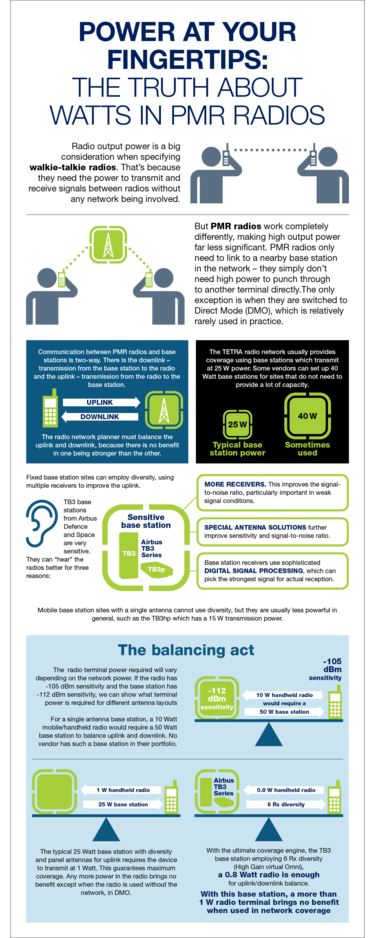Did you believe that higher output power in your TETRA radio gets you better radio coverage? If so, think again.
Many people have the wrong idea about how powerful their TETRA radios need to be. They think that more Watts in output power will ensure maximum coverage. This is true only for simple walkie-talkies: they need high power to transmit and receive signals between radios, because they operate without a network.
Check this infographic which explains the truth about Watts in TETRA radios.
But TETRA radios are not simple walkie-talkies. TETRA radios use a powerful network to communicate so they don’t need a high output power to get through to each other directly. The only exception is if they are switched to Direct Mode (DMO).
There are three things that affect TETRA radio coverage significantly more than the output power of the radio terminal:
- Base station sensitivity
- The quality and location of the radio antenna
- Power balance.

More coverage when a base station "hears" well
TETRA radios communicate with the network’s base stations, back and forth with each other. A good, sensitive and optimized base station, such as the TB3-series TETRA base station, listens well, especially when equipped with the recommended antenna solution. The radios do not have to transmit with high power, and the base station still "hears” them. (The new TB4 hybrid base stations have the same capability, and in addition, they offer TETRA evolution towards 4G/5G.)
It is important that the base station is a “good listener,” because when the radio uses less power, its battery will last longer. It can make a critical difference to professionals in the field who don’t want to be let down by a flat battery when they most need their radio.
Handpicked related content -
You can do things to make the battery of your radio last longer. The blog post "What you need to know about radio battery life" gives you a list of 7 good tips.
A better antenna means better coverage
Hah, you may say, vehicle radios are more powerful and they enjoy better coverage.
Yes, it’s true, mobile radios do have more output power - but that’s not why they get service in places where handhelds might struggle. They get service mainly because they have an antenna that
- is of good quality and high gain
- has metal grounding
- is in just the right place and position, outside the car
- points towards the nearest base station.
Even handhelds in the car are placed in special cradles which are connected to the car antenna.
Because the radio antenna is outside, the user’s body cannot block the signals for the radio in the car. When the user’s body blocks signals, it is called body loss and it can seriously affect the coverage that handheld radios enjoy.
Users tend to prefer short antennas or antennas that are enclosed inside the handheld radio. Such a radio is convenient to carry on the belt, but it is far from optimal, considering coverage.
Radio coverage is a sum of several parameters, and antenna is one of them.
Power balance - the deciding factor
Think of radio output power as an engine of a car. A car with a 3-liter engine and the maximum speed of 250 km/h won’t get a free lane on the motorway to get faster to its destination. It will also have the same speed limit as a smaller car with a 1.4-liter engine and 180 km/h speed. The bigger car will only consume more fuel!
PMR radio output power is similar – it also has a “speed limit” because it operates in radio a network where uplink and downlink must be in balance.
- Uplink means the transmission from the radio “up” to the base station.
- Downlink is the transmission from the base station “down” to the radio.
There is no point in one being stronger than the other. Download the infographic which illustrates this and explains the truth about Watts in TETRA radios.
Let’s take an example: a TETRA radio network whose base stations usually transmit at 25 Watts. What is the optimal output power for a radio operating in such a network?
The optimal output power is calculated from the sensitivity figures of the radio terminal and the base station. Let's say that:
- the radio has -105 dBm sensitivity
- the base station has -112 dBm sensitivity.
In this case, the typical 25 W base station with diversity and panel antennas for uplink will require the device to transmit at 1 W. This is the optimal output power and it guarantees maximum coverage or maximum PMR range.
In other words, a radio transmitting at 1,5 W or even at 3 W will not get any more PMR radio range. It will only use up its battery faster.
More power than that in the radio brings no benefit, except if the radio is used in DMO.
Would a 10 W radio even work?
If there were an impressively powerful TETRA radio capable to transmit at 10 W, it would require a base station transmitting at 50 W. The only thing is that no such base station exists.
So beware of claims that more TETRA radio power will make for a superior radio. It’s not true.
Do not look only at the Watts that the radio promises. You don’t need a very powerful radio to get the radio range that you need. On the contrary: using more power than necessary can actually degrade your operational efficiency and lead to more communication challenges.
This infographic explains the truth about Watts in TETRA radios. Download the infographic in printable format:

You may also want to check the TETRA radios from Airbus – they all have excellent sensitivity.
-----
Editor’s note: This post was originally published in February 2016 and has since been reviewed and updated for accuracy and comprehensiveness.






